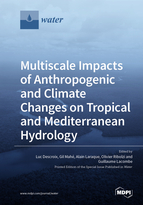Multiscale Impacts of Anthropogenic and Climate Changes on Tropical and Mediterranean Hydrology
A special issue of Water (ISSN 2073-4441). This special issue belongs to the section "Hydrology".
Deadline for manuscript submissions: closed (31 July 2020) | Viewed by 1109324
Special Issue Editors
Interests: hydrology; land use changes; climate change; impacts on water cycle
Interests: hydrology; climatology; solid transport; human impact; environment; hydrological modelling; climatic scenarios
Special Issues, Collections and Topics in MDPI journals
Special Issue Information
Dear Colleagues,
In most Tropical and Mediterranean areas, landscapes, soils and territories are experiencing new vulnerabilities, facing global warming and accelerating changes in land use. Long droughts, dry spells, rainfall intensification, and an increase in number of storms and cyclones make agriculture as well as land management and water and sediment control more difficult. In many regions, the population increase is too strong to allow cropping and rural activities to easily reach a “boserupian” behavior. The intensification of the climatic cycle commonly leads to an acceleration of the hydrological cycle, increasing the occurrence of flooding, inundation, as well as droughts and water shortages. Human actions and overall rural activity can strongly modify water runoff and infiltration, then water balance, by increasing infiltration and buffering the water cycle, or on the contrary, by increasing runoff and accelerating the water cycle. Rural practices are commonly suspected to decrease the soil water-holding capacity. This could lead to a rise in flooding occurrence and intensity downstream, and on site they cause edaphic drought in areas where no climatic drought is observed.
These kinds of changes influence hydrology and erosion, with implications for various risks: food insecurity, natural disasters (landslides, flood damage), water shortages and pathogenic contaminations. The accelerating pace of these environmental changes leaves limited time for adaptation. While the need for “climate change adaption” is recognized, there is also a need for land-use change adaptation. To date, there is limited understanding of the processes linking land use management to these risks.
There is a need to understand causal chains of processes, from land-use, vegetation structure, soil, erosion, hydrological connectivity (surface and subsurface) infiltration and then related risks to better manage these risks and reduce them. Multi-scale approaches are relevant because there are multi-scale impacts; the micro-plot and hillslopes are relevant to understand processes controlling soil detachment and the partition of rainfall into surface and subsurface flow in relation with interacting land use and soil surface dynamics. At the watershed level, local dynamics translate into risks of hydrological extremes, erosion and contamination, threatening downstream populations and ecosystems.
Dr. Luc Descroix
Dr. Gil Mahé
Dr. Alain Laraque
Dr. Olivier Ribolzi
Dr. Guillaume Lacombe
Guest Editors
Manuscript Submission Information
Manuscripts should be submitted online at www.mdpi.com by registering and logging in to this website. Once you are registered, click here to go to the submission form. Manuscripts can be submitted until the deadline. All submissions that pass pre-check are peer-reviewed. Accepted papers will be published continuously in the journal (as soon as accepted) and will be listed together on the special issue website. Research articles, review articles as well as short communications are invited. For planned papers, a title and short abstract (about 100 words) can be sent to the Editorial Office for announcement on this website.
Submitted manuscripts should not have been published previously, nor be under consideration for publication elsewhere (except conference proceedings papers). All manuscripts are thoroughly refereed through a single-blind peer-review process. A guide for authors and other relevant information for submission of manuscripts is available on the Instructions for Authors page. Water is an international peer-reviewed open access semimonthly journal published by MDPI.
Please visit the Instructions for Authors page before submitting a manuscript. The Article Processing Charge (APC) for publication in this open access journal is 2600 CHF (Swiss Francs). Submitted papers should be well formatted and use good English. Authors may use MDPI's English editing service prior to publication or during author revisions.
Keywords
- climate change
- land use/land cover changes
- water holding capacity
- connectivity
- risks







